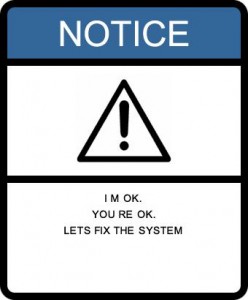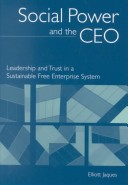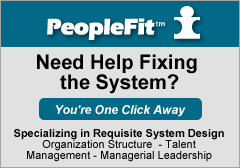Merry Christmas – Hope, Peace, Joy
By Michelle Malay Carter on December 24, 2008
Filed Under Personal Observation | 3 Comments
What Employees Want for Christmas – The Gift of Clarity
By Michelle Malay Carter on December 22, 2008
 -A clear picture of their role, and clear assignments.
-A clear picture of their role, and clear assignments.
-A role matched to their current cognitive capability level.
-Accountability matched with requisite authority.
-A manager who adds value to their thinking.? (aka has cognitive capacity one level higher than the employee)
-Explicitly defined role relationships with others?as arranged by their manager.? Employees?shouldn’t be left to beg or manipulate others to get their work done.?(For example, if A and B disagree, who decides?? If A needs services from B, what is B’s obligation to A?? If A recommends something to B, must B do it or can B choose to decline idea?)
The Alternative
Or, you could hire them into a role that bores them to tears, and then micromanage them on the details while leaving them to guess about their role and assignments and then coach them for not being better at reading your mind.? You can send them off to fight like a contentious sibling with peers and colleagues in order to get their work done, and?then tie?up?a large percentage of their pay in a?bonus plan that they really cannot influence one way or another.? And round it off with a?polo shirt with your company’s logo?and a season’s greetings card.
I’m OK.? You’re OK.? Let’s fix the system.
Filed Under Accountability, Employee Engagement, Managerial Leadership, Requisite Organization, Talent Management, Work Levels | 5 Comments
Who Gets a Seat at the Table? What are You Trying to Do?
By Michelle Malay Carter on December 15, 2008
 I mentioned Warren Kinston in a previous post.? He is a high level thinker in the areas of values, hierarchies, and organizational structure.
I mentioned Warren Kinston in a previous post.? He is a high level thinker in the areas of values, hierarchies, and organizational structure.
I usually have to read his work more than once, and I walk away with some kernels of insight.? Not because there are only a few kernels to be had, but because that is all I can contain.
From the?Journal of Applied Systems Analysis…
I was revisiting his journal article, A New Model of Managing Based on Levels of Work, (thanks to Manasclerk at Requisite Writing?for posting it), and I came away with a neophyte but useful understanding of the work of different groupings of levels within organizations.? This, in one sense, is very simplistic.? But don’t dismiss it too quickly.?? Think about the following principles and see if they make gut level sense.
Who Should Get an Invitation?
- If you need to make decisions, invite two levels to a meeting.? (Three will bog it down.)
- If you want to plan and manage change, you’ll need to invite three levels.??(Two will be incomplete.)
- For implementation, one level will do it.
Kinston details seven levels, but these are the ones I have a handle on at the moment.? There is much more here that I will continue to digest.? Let me know if you read it and pick up some kernels yourself.
I’m OK.? You’re OK.? Let’s fix the system.
Filed Under Accountability, Executive Leadership, Managerial Leadership, Organization Design, Requisite Organization, Work Levels | 1 Comment
Innovation at Work Level 1 – A Friday Fascinating
By Michelle Malay Carter on December 12, 2008
My post, Innovation Snobbery Is Not Serving Organizations, which started as?my response to Harvard Business online’s question, What’s Management’s Role in Innovation?,?is one of my most visited posts.
Biased Expectations = Limited Potential
My contention is that all work is creative and all humans are wired to work.? All levels of the organization are accountable to deliver innovation.? Limiting innovation expectations to elite groups, skunk works, or upper levels of the organization limits the potential of an organization.
Expect Innovation from Everyone
Even though work at level one is procedural, it is not mindless.? The accountability at level one is to refine or improve personal skills and knowledge.? Take?43 seconds?out of your day to watch this Friday fascinating example of incredible innovation in a level one role (carry bricks from the boat to the shore).
?
Filed Under Accountability, Corporate Values, Employee Engagement, Managerial Leadership, Requisite Organization, Talent Management, Work Levels | Comments Off on Innovation at Work Level 1 – A Friday Fascinating
Requisite Organization Introduction Public Course – January 7, Raleigh-Durham, NC, USA
By Michelle Malay Carter on December 1, 2008
 For those of you interested in learning the fundamental elements of Requisite Organization, we’re having another public course.? Love to see you there!
For those of you interested in learning the fundamental elements of Requisite Organization, we’re having another public course.? Love to see you there!
Quite a bit of what I write and rant is rooted in Elliott Jaques’ meta-model, Requisite Organization.
On January 7th, I’ll be co-leading a short course on some of the basics of the model and their implications for organizational structure, employee engagement, leadership, talent management and systems design.
Seating is Limited!
Please consider joining us.? Click here to read more about the course or to register.
I’m OK.? You’re OK.? Let’s fix the system.
Filed Under Employee Engagement, Requisite Organization, Talent Management | 2 Comments
Thanksgiving and Happiness Linked
By Michelle Malay Carter on November 27, 2008
 It’s Thanksgiving in the United States, and although the average US standard of living has steadily risen over the last decades, self-reported happiness has declined.?
It’s Thanksgiving in the United States, and although the average US standard of living has steadily risen over the last decades, self-reported happiness has declined.?
Thanksgiving provides us an opportunity to remind ourselves that things do not make for happiness.
Gratitude Research
Dr. Robert A. Emmons wrote a book, thanks!,?detailing his research on gratitude.? His ten-week experiment involved three groups.
1. The first group was asked to write down five things that happended in the last week for which they were grateful.
2. The second group was asked to write down five daily hassles from the previous week.
3. The third group simply listed five events that had occurred in the last week, but not told to focus on positive or negative aspects.
Happiness Increased 25%
People who were in the gratitude group (#1) felt fully 25% happier – they were more optimistic about the future, they felt better about their lives and they even did almost 1.5 hours more exercise a week than those in the hassles group?(#2)?or events condition group (#3).
Whether it is Thanksgiving in your native land today or not, taking a gratitude posture seems to be a healthy idea.
Thank You
I’m off to spend the weekend with family in Richmond, Virginia.? I thank you for your support and readership!? See you next week.
Filed Under Corporate Values, Personal Observation | 2 Comments
CEO Leadership – Key Points to Understand
By Michelle Malay Carter on November 23, 2008
 Elliott Jaques wrote Social Power and the CEO: Leadership and Trust in a Sustainable Free Enterprise System?in 2002.? It’s worth reading.? If you don’t care to read the whole book, an excellent summary was published by Business Book Review.
Elliott Jaques wrote Social Power and the CEO: Leadership and Trust in a Sustainable Free Enterprise System?in 2002.? It’s worth reading.? If you don’t care to read the whole book, an excellent summary was published by Business Book Review.
A reprint of the review was published in Organization Design, Levels of Work & Human Capability which you can download for free, here.
Here are some key points worth considering, as quoted and parphrased from the book review:
Accountability and Authority
“Because accountability and authority are at the heart of all interpersonal relationships, managerial hierarchies gain their success or failure through the success or failure of the working relationships between and among their people.”
The Collaboration Conflict of Interest
“Despite the deep importance of work to people, and despite the satisfaction gained from having conditions that allow effective collaboration in the that work, difficulties in ensuring such cooperation have been a perennial problem in managerial systems, where self-interest and employee rivalry are persistent issues.”?
“During the past 50 years or so, attempts have been made to overcome this problem via the introduction of group dynamics training, the use of group decision making, self-managed teams, and various kinds of group and department bonuses and profit sharing.”
The Employee Contract
“While these approaches may be effective in the short term, they are not sustainable over time because they are in direct conflict with the contract under which all employees have always worked.? The contract is between the employer and individual, not the group.”
CEOs must understand that people are not employed as groups and cannot be held responsible for working as an accountable group – only a board of directors can be held accountable as a body.
I’m OK.? You’re OK.? Let’s Fix the System
“They must also understand that human behavior in managerial systems is determined by the people systems set by the CEO and the board AND NOT by the psychopathology of each individual.”
Your thoughts?
Filed Under Accountability, Corporate Values, Executive Leadership, Managerial Leadership, Organization Design, Requisite Organization, Work Levels | 2 Comments
What is the Opposite of a Yes Man? A Friday Funny
By Michelle Malay Carter on November 21, 2008
Do You Agree?
This week we’ve been talking about emotions.? For most of us, nothing stirs them up more than an opposing viewpoint.
My client used a term for?a non-yes woman the other day that was so spot on that I can’t get it out of my head.? I wasn’t sure where the term fell on the offense continuum so I did some research and Webster says the term can be vulgar.? So therefore, it is not always.? Please take this as one of the not always instances.? Disclaimer:? This post is not necessarily a reflection of the views or vocabulary of my sponsors.? :)
I’m Big Enough to Take It
We all like to think that we are “big” enough to want others to confront and challenge us, but the reality is that in the face of it, we often become defensive, offended, and begin to revile the (here comes the term) turd in the punchbowl.
Loyal versus Principled?
Joe Lieberman is dealing with being a turd in the punchbowl as we speak.? Interesting question, should loyalty trump standing for your principles?? No one knows what to do with him.?? Obama is having to make decisions about whether he wants opposing viewpoints represented in his cabinet.
Turds for Hire
Consultants are often hired to play this role in the organization so as to protect those on the inside.? Bloggers seem to?revel in playing the role.
Laugh a Little – We’re All Human
All of this talk reminds of a scene from Caddyshack.? I couldn’t find one clip so I included two short ones.?
The first 44-second clip shows a typical emotional reaction to a “turd in the punchbowl”.??
The second shows that although a turd may often be a fall guy, it may not be as evil as we portray it to be.? Take another 33 seconds out to laugh at Bill Murray.
The Lonely Life of a Turd
Turds – Not as Bad as We Make Them Out to Be?
Are you a yes man or a turd in the punchbowl?
Filed Under Corporate Values, Personal Observation, Strategy | 2 Comments
Don’t Feel that Way. Feel Better?
By Michelle Malay Carter on November 19, 2008
 A Common, but Misguided?Strategy
A Common, but Misguided?Strategy
Trying?to make a person feel better by telling them not to feel what they are feeling is a strategy doomed to fail.??
How often do we, with the best of intentions,?tell people not to feel the way they do?
- Don’t be upset.? It’s not that big of a deal.
- Don’t whine.? It could be worse.
- Why are you upset about that?
When a person is upset, telling them they shouldn’t be upset usually only makes them more attached to the feeling and determined to defend it.
Explaining Away Feelings Doesn’t Work
Isn’t it?the equivalent of telling a person who says she’s hungry that she just ate.? Will that change her feeling?? If someone is cold, will announcing the temperature in the room make them feel warm?
The best thing to do is give the person the space and permission to feel what they do.? As I said in my last post, once they feel heard and understood, they will be in a better place to be rational.? This may be all they need to release the emotion themselves and move on.
Validate – Whether You Agree or Not
Maybe they will continue to cling to the emotion.? Even so, by validating their feelings you have strengthened your relationship with them, rather than damaging it with misguided attempts to make them feel better and/or snap out of it.
Validating another’s emotion is nothing more than acknowledging that they are feeling it.? You need not even agree with it to acknowledge it.? Something as simple as, “I know this is very upsetting for you,” can do wonders.
Plucked from the Headlines of My Life
As I mentioned, my 10-year-old son has dysgraphia, and he attends three hours of after school therapy a week aimed at strengthening his ability to get words on paper.? To add insult to injury, the therapy has homework.? Most Sunday afternoons, overcome by the injustice of it all, he melts down, cries, and rolls?on my office floor when faced with copying several sentences out of a book as part of his homework.
As his Mom, this breaks my heart.? I want to fix it for him, but I can’t.? Instead, I simply?agree with him, empathize that it’s hard, it’s unfair, and it’s grueling for him.? After about 10 or 15 minutes, he wipes his tears, gets up, does his homework, and then goes outside to play with his friends.?
I don’t suspect my telling him that “it’s really not that hard”, or to “suck it up and be a man” or that “others have hit worse”?would change the way he feels, but it might change the way he feels about me.
If you want to be a person of influence in others’ lives, give them space to feel what they feel.
I’m OK. You’re OK.? Let’s fix the system.? How do you feel about this?
Filed Under Corporate Values, Employee Engagement, Managerial Leadership | Comments Off on Don’t Feel that Way. Feel Better?
It’s Irrational to be Rational with the Emotional
By Michelle Malay Carter on November 17, 2008
 One of the easiest ways to make an emotional situation worse is to offer rationalizations before dealing with the emotional aspects of a situation.? Whether you are a manager, a customer service representative, or a resident of planet earth, my advice to you is ignore others’ emotions at your peril.
One of the easiest ways to make an emotional situation worse is to offer rationalizations before dealing with the emotional aspects of a situation.? Whether you are a manager, a customer service representative, or a resident of planet earth, my advice to you is ignore others’ emotions at your peril.
Emotion Up, Rational Down
Picture emotional and rational as two ends of a see-saw.? When one is up, the other is down.? When you are conversing with an emotional person, you must validate their emotions before you move to problem solving.
People Repeat Themselves When They are not Feeling Heard
When people feel unheard, the usually repeat themselves more LOUDLY.? So the next time someone is screaming at you when you believe your message is making all the sense in the world, ask yourself, have I acknowledged their feelings?
For example, if you are a drycleaner who has just lost some one’s favorite pair of pants, pointing at your limit of liability statement posted on the wall is only going to escalate the situation.
Instead, why not?try:
- I can understand why you are upset.? I would be too.
- I see that you are (insert emotion) about this.
- I’m sorry about this.
- I know a good-fitting pair of pants can be hard to find.
Once people feel heard and understood, they will be in a more open place to work with you on a rational basis.
Delivering Bad News?
If?you are having to deliver bad news within your organization, be sure your message is not singly focused upon the justifications for the decision?while ignoring?the pain, sadness, and fear that the actions might cause (however justified they are).??Organizations?that deny the?emotional aspects of their decisions?should beware of the employee who decides that he will be heard, and you will understand his pain.
I’m OK.? You’re OK.? Let’s fix the system.? How do you feel about this?
Filed Under Corporate Values, Employee Engagement | 9 Comments

